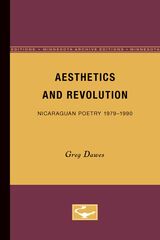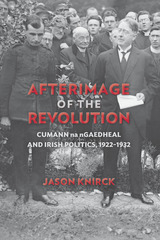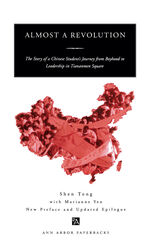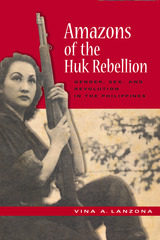211 books about Revolution and 7
start with A
211 books about Revolution and 7
211 books about Revolution
7 start with A start with A
7 start with A start with A

Administration of a Revolution
Executive Reform In Puerto Rico Under Governor Tugwell, 1941-1946
Charles True Goodsell
Harvard University Press

Aesthetics and Revolution
Nicaraguan Poetry 1979-1990
Greg Dawes
University of Minnesota Press, 1993
The distinction in North Atlantic cultures between aesthetics and politics, argues Greg Dawes, is artificially constructed because it does not take into account the socially based origins of these spheres. Although it is true that intellectuals and artists often function as politicians or diplomats in Latin America and that they are relegated to an autonomous realm in North America, the fact remains that aesthetics in both regions is embedded in sociohistorical events.
In Aesthetics and Revolution, Dawes demonstrates that there is an objective grounding for cultural studies found in the aesthetic means of production. By analyzing the relations and forces of production in this realm we inevitably cross over into the economic means of production as well as the struggle for political representation. Ultimately, aesthetics is at the intersection of class and gender interests and their struggle for hegemony.
In Aesthetics and Revolution, Dawes has chosen a group of writers of different theoretical sympathies, class, gender, and social positions to reveal the conflictual interests of the social classes and genders as a whole. Through close readings of their work, Dawes examines the thematic nodes that are expressed in positions as diverse as Ernesto Cardenal’s liberation theology, Pablo Antonio Cuadra’s populism, the campesino’s oral tradition, and Gioconda Belli’s erotic verses in relation to the changes taking place in revolutionary Nicaragua.
In Aesthetics and Revolution, Dawes demonstrates that there is an objective grounding for cultural studies found in the aesthetic means of production. By analyzing the relations and forces of production in this realm we inevitably cross over into the economic means of production as well as the struggle for political representation. Ultimately, aesthetics is at the intersection of class and gender interests and their struggle for hegemony.
In Aesthetics and Revolution, Dawes has chosen a group of writers of different theoretical sympathies, class, gender, and social positions to reveal the conflictual interests of the social classes and genders as a whole. Through close readings of their work, Dawes examines the thematic nodes that are expressed in positions as diverse as Ernesto Cardenal’s liberation theology, Pablo Antonio Cuadra’s populism, the campesino’s oral tradition, and Gioconda Belli’s erotic verses in relation to the changes taking place in revolutionary Nicaragua.
[more]

Afterimage of the Revolution
Cumann na nGaedheal and Irish Politics, 1922–1932
Jason Knirck
University of Wisconsin Press, 2014
Ascending to power after the Anglo-Irish Treaty and a violent revolution against the United Kingdom, the political party Cumann na nGaedheal governed during the first ten years of the Irish Free State (1922–32). Taking over from the fallen Michael Collins and Arthur Griffith, Cumann na nGaedheal leaders such as W. T. Cosgrave and Kevin O'Higgins won a bloody civil war, created the institutions of the new Free State, and attempted to project abroad the independence of a new Ireland.
In response to the view that Cumann na nGaedheal was actually a reactionary counterrevolutionary party, Afterimage of the Revolution contends that, in building the new Irish state, the government framed and promoted its policies in terms of ideas inherited from the revolution. In particular, Cumann na nGaedheal emphasized Irish sovereignty, the "Irishness" of the new state, and a strong sense of anticolonialism, all key components of the Sinn Féin party platform during the revolution. Jason Knirck argues that the 1920s must be understood as part of a continuing Irish revolution that led to an eventual independent republic. Drawing on state documents, newspapers, and private papers—including the recently released papers of Kevin O'Higgins—he offers a fresh view of Irish politics in the 1920s and integrates this period more closely with the Irish Revolution.
[more]

Alexis de Tocqueville on Democracy, Revolution, and Society
Alexis de Tocqueville
University of Chicago Press, 1980
Alexis de Tocqueville possessed one of the most fertile sociological imaginations of the nineteenth century. For more than 120 years, his uncanny predictive insight has continued to fascinate thinkers, and his writings have continued to influence our interpretations of history and society. His analyses of many issues remain relevant to current social and political problems. In this volume John Stone and Stephen Mennell bring together for the first time selections from the full range of Tocqueville's writings, selections that illustrate the depth of his insight and analysis.
[more]

Almost a Revolution
The Story of a Chinese Student's Journey from Boyhood to Leadership in Tiananmen Square
Shen Tong
University of Michigan Press, 1998
In his groundbreaking memoir about China's democracy movement and the massacre at Tiananmen Square in June 1989, student leader Shen Tong offers us a rare look at a bold and daring new generation of Chinese citizens who tried to protest the restraints imposed by their country's government. An organizer of the "dialogue delegation," whose goal was to negotiate with the government, Shen provides an insider's record of the day-to-day decisions that led up to June 4th. Written with the help of journalist Marianne Yen, the result is both a powerful documentary and a sensitive account of growing up in contemporary China.
Now nearly ten years later as our fascination with post-Deng China continues to develop, Shen's story and the updated material he provides are weighted with increasing significance. Coupled with much of the recent analysis, Shen's firsthand account vividly contextualizes the Chinese government's opposition to democracy and offers meaningful insight into a country that promises to occupy an increasingly prominent position in the world.
"A cause for celebration . . . an important contribution to China's newly discovered historical memory." --New York Times Book Review
Shen Tong is a doctoral student in political sociology at Boston University and the founder of the Democracy for China Fund, which aims to support and publicize dissent networks in China. Marianne Yen is a former New York correspondent for the Washington Post.
Now nearly ten years later as our fascination with post-Deng China continues to develop, Shen's story and the updated material he provides are weighted with increasing significance. Coupled with much of the recent analysis, Shen's firsthand account vividly contextualizes the Chinese government's opposition to democracy and offers meaningful insight into a country that promises to occupy an increasingly prominent position in the world.
"A cause for celebration . . . an important contribution to China's newly discovered historical memory." --New York Times Book Review
Shen Tong is a doctoral student in political sociology at Boston University and the founder of the Democracy for China Fund, which aims to support and publicize dissent networks in China. Marianne Yen is a former New York correspondent for the Washington Post.
[more]

Amazons of the Huk Rebellion
Gender, Sex, and Revolution in the Philippines
Vina A. Lanzona
University of Wisconsin Press, 2009
Labeled “Amazons” by the national press, women played a central role in the Huk rebellion, one of the most significant peasant-based revolutions in modern Philippine history. As spies, organizers, nurses, couriers, soldiers, and even military commanders, women worked closely with men to resist first Japanese occupation and later, after WWII, to challenge the new Philippine republic. But in the midst of the uncertainty and violence of rebellion, these women also pursued personal lives, falling in love, becoming pregnant, and raising families, often with their male comrades-in-arms.
Drawing on interviews with over one hundred veterans of the movement, Vina A. Lanzona explores the Huk rebellion from the intimate and collective experiences of its female participants, demonstrating how their presence, and the complex questions of gender, family, and sexuality they provoked, ultimately shaped the nature of the revolutionary struggle.
Drawing on interviews with over one hundred veterans of the movement, Vina A. Lanzona explores the Huk rebellion from the intimate and collective experiences of its female participants, demonstrating how their presence, and the complex questions of gender, family, and sexuality they provoked, ultimately shaped the nature of the revolutionary struggle.
Winner, Kenneth W. Baldridge Prize for the best history book written by a resident of Hawaii, sponsored by Brigham Young University–Hawaii
[more]

At the Corner of a Dream
A Journey of Resistance and Revolution: The Street Art of Bahia Shehab
Bahia Shehab
Gingko, 2019
Working with stylized typographic and calligraphic forms, Egyptian-Lebanese street artist Bahia Shehab brings creative presentations of language and culture to public spaces around the world. During the Egyptian revolution of 2011, she began taking to the streets to paint. Starting in Cairo, Shehab began creating large-scale public art as a form of resistance against military rule and violence. With her spray can in hand, this artist, designer, and historian set out to spread beautiful and empowering images in the face of tumultuous times. Now she has taken her peaceful resistance to the streets of the world, creating works in cities from New York to Tokyo, Amsterdam, and Honolulu. Engaging with identity and the preservation of cultural heritage, Shehab creates work that investigates Islamic art history and reinterprets contemporary Arab politics, feminist discourse, and social issues. Internationally renowned, Shehab’s work has been on display in exhibitions, galleries, and city streets across the world and has earned her a number of international recognitions and awards, including the BBC 100 Women list, TED Senior fellowship, and a Prince Claus Award. In 2016, she became the first Arab woman to receive the UNESCO-Sharjah Prize for Arab Culture.
At the Corner of a Dream offers extensive documentation of Shehab’s powerful street paintings. It also chronicles the stories of the people she meets along her journeys and includes her observations from the streets of each new city she visits. Shehab’s work is a manifesto, a cry for freedom and dignity, and a call to never stop dreaming.
At the Corner of a Dream offers extensive documentation of Shehab’s powerful street paintings. It also chronicles the stories of the people she meets along her journeys and includes her observations from the streets of each new city she visits. Shehab’s work is a manifesto, a cry for freedom and dignity, and a call to never stop dreaming.
[more]
READERS
Browse our collection.
PUBLISHERS
See BiblioVault's publisher services.
STUDENT SERVICES
Files for college accessibility offices.
UChicago Accessibility Resources
home | accessibility | search | about | contact us
BiblioVault ® 2001 - 2024
The University of Chicago Press









